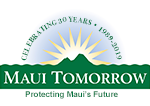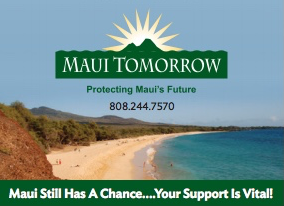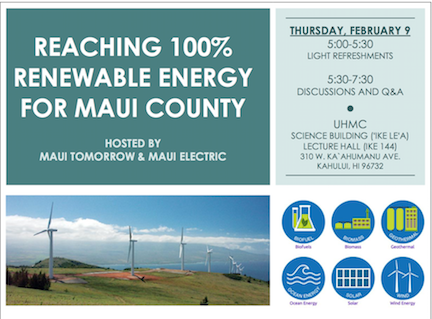From: Professor (Emeritus) Dick Mayer March 23, 2012
dickmayer@earthlink.net Cell 808-283-4376
1111 Lower Kimo Dr. Kula, Maui, HI 96790
RE: Ulupalakua Geothermal Mining Lease and Geothermal Resource
Subzone Modification Application (EISPN)
Applicant: Ormat Technologies Inc., 6225 Neil Road, Reno, NV 89511.
Contact: Bill Sherman, (775) 356-9029 Ext. 32232
Approving Authority: Hawai‘i State Board of Land and Natural Resources, P.O. Box 621,
Honolulu, HI 96809. Contact: Carty Chang, (808) 587-0230
Consultant: Geometrician Associates, PO Box 396, Hilo, HI 96721.
Contact: Ron Terry, (808) 969-7090
RE: Comments on ORMAT’s Maui Geothermal EISPN These comments are intended to apply to: (1) a geothermal mining lease of reserved lands occupied by Ulupalakua Ranch, Inc.; (2) a geothermal mining lease of State lands adjacent to Ulupalakua Ranch; (3) modification (expansion) of an existing Geothermal Resource Subzone (GRS); and
(4) any HRS 343 Environmental review, NEPA requirements, Conservation District Use permitting, Special Management Area Use, Maui County Special Use, Request for Use of State Lands, Incidental Take Permit, Incidental Take License, Use and Occupancy Agreement, County Right-of-Way Approval, Various Grading/Building and Other Construction Permits.
——————————————————————————————————————-
Aloha, I first wish to state that I’m strongly in favor of developing renewable energy resources on Maui so that we will not have to continue burning fossil fuels. Nevertheless, I feel it is necessary to make sure that any new alternative energy project: a) be sensitive to Maui’s special physical and cultural environment; and b) provides benefits to electricity consumers. Therefore, the following is a list of items which should be considered in developing both the Draft/Final-EIS.
—————————————————————————————————————
I request that the following information be given and questions be answered in the EIS:
NOTE: All references to page numbers refer to the EISPN.
-
Clearly indicate a timeline sequence for the numerous, different actions that are covered by the EIS:
acquiring State mining leases; expanding the GRS; getting permits and other approvals from State and County authorities necessary to conduct exploratory drilling in the project area; determining the number and location(s) of exploratory wells; preparation of an Environmental Assessment (EA) or other follow-up documentation as may be required by Chapter 343, HRS, etc.
And then (EISPN Page 6):
“If exploratory drilling and testing lead to discovery of a commercially useable geothermal resource, Ormat would then determine the feasibility of constructing a plant to generate electricity using the resource and selling the electricity to an off-taker such as Maui Electric Company. Ormat would select an optimum location for a geothermal plant that maximizes the efficiency of the operation and minimizes adverse impacts. Ormat would finalize details of the plant’s size, interconnection to the Maui Electric Company grid, and other characteristics, and would prepare follow-up documentation as may be required by Chapter 343, HRS, and other regulatory requirements, that addresses the construction and operation of the plant, including road use.”
ORMAT’s ULUPALAKUA GEOTHERMAL EISPN Dick Mayer 3/23/2012 Page 2
And also, there is the Purchase-Power Agreement with MECO, or the County (which could wheel the electricity to its many water pumps or for street lighting).
-
This EISPN discusses such a complex set of actions. This is commendable since, all too often, projects make an effort to segment their multi-stage activities.
However, in this case, there is a very serious problem because all of the successive segments and their impacts cannot now be fully addressed by this EIS since even a general site location for the wells and the power-plant have not been even vaguely located, – except somewhere in a 5,000+ acre, multi TMK region.
(P. 24 mid) “As the actual locations for geothermal infrastructure such as wells, roads and power plants will not yet be able to be identified during the EIS process, the Draft EIS will focus on identifying areas in which disturbance should be avoided or minimized to reduce biological impacts.”
Consequently, a “Supplemental EIS” describing the impacts and mitigation measures will be needed and should be included as an expected activity in this EIS when the proposed sites (especially for the power plant, utility line corridors, and the various roads) have been determined.
-
Many TMKs have been described. The EIS should include a map showing the TMKs and their individual acreages. Are the TMKs inside or outside of the GRS?
-
Justification is needed for expanding the GRS. The present GRS was previously the subject of and determined by a public hearings process.
-
(Page 7 bottom) What will be the effect on the Ulupalakua Ranch and Tedeshi Winery operations at each stage of the activities (exploration for a site? construction? Plant operations?)? Will their viability as agricultural and tourist operations be affected or threatened?
-
(Page 25) “Hawaiian sensitivities” are given special consideration in the 1996 Makawao-Pukalani-Kula Community Plan and need to be discussed in the EIS.
“The Upcountry region contains the only designated geothermal subzone in the County. While the potential benefits of geothermal development would accrue to the entire island, the environmental impacts would be primarily borne by the communities of Ulupalakua and Kanaio. For this reason, and in respect to Native Hawaiian sensitivities, a policy prohibiting geothermal development that impacts adversely on Upcountry communities or culturally sensitive resources has been adopted.”
-
Wind direction may play an important role. It should be carefully monitored and described in the EIS. The wind regime may be quite different on each side of the SW ridge line; and different during day-light and night-time periods.
-
(Page 29, Last Paragraph) These lands are an important agricultural resource. Consequently, this EIS should make an explicit declaration that no additional industrial activities are going to be located within this Geothermal Subzone, especially activities that might try to take advantage of the produced electricity or heated water. The Upcountry community does not want this to become an industrial site; the natural beauty and serenity of the area is critical.
ORMAT’s ULUPALAKUA GEOTHERMAL EISPN Dick Mayer 3/23/2012 Page 3
-
Describe in detail the bonding that will be provided: a) to clean up spills and other types of environmental damage (P. 21 2nd + 3rd paragraphs); and b) to pay for the eventual costs of decommissioning the site and restoring the land to its present condition.
Decommissioning The Project De-commissioning of the project at the conclusion of its life span will necessitate considerable costs. A “sinking fund” should be established that will allow for either a complete de-commissioning and for the removal of the power plant and any above ground facilities. Without a proper fund being available, these facilities may remain as a permanent blight on the Ulupalakua Ranch landscape.
-
MAPS (Pages 2-4)
-
Specifically, Ulupalakua Ranch Headquarters should be designated on each of the maps.
-
Locate the vineyard fields.
-
The SEMPRA Power Line Corridor should be on the maps.
-
Ulupalakua Ranch’s large Dedicated Conservation Area should be indicated on the maps and description of the limitations of that area should be in the EIS text.
-
Map of homes and residential areas: The EIS will be better understood if it is clear where the actual residences are located in relationship to the potential impacts. The EIS should clearly map locations of all actual and entitled residences that may be impacted by construction, traffic, drilling, plant operations, noise, and/or lights.
-
“Sustainability” is a high virtue. However, experience on the Big Island has shown that the magma heat source shifts and is not everlasting, necessitating the periodic drilling of new wells. Discuss the possibilities and probabilities of successive well drilling over the long run.
12. Electricity Transmission Route (Power Plant Tie-In) More details must be provided in the EIS for linking up with the SEMPRA or some new the transmission corridor. Specifically, how close (in feet) are the closest neighboring residences? Where will the transmission line cross the Kula Highway?
13. Noise The EIS must discuss the noise resulting from the drilling and geothermal operations.The EIS should be very explicit in describing the decibel impacts from all activities: Trucking? Drilling? Blasting? Excavating? Jack-hammers?
How many and which homes will be impacted by noise? And what levels of this noise will be heard in any residence
13. Lights The flight paths of endangered birds may be at stake. Will there be any nighttime transporting, drilling, construction, and/or other activities which will require lighting? Describe in detail the number of lights and their brightness. What can be done to mitigate the “light pollution” in this otherwise dark and pristine area?
15. Construction Timeframe For how long will the residents of the remote Kahikinui and Kanaio communities have to deal with construction activities? For how long will residents in neighboring communities (Kula and South Maui) have to deal with trucking operations from/to the site? What can be done to mitigate disruptions in the lives of these communities?
ORMAT’s ULUPALAKUA GEOTHERMAL EISPN Dick Mayer 3/23/2012 Page 4
16. Solid Waste Where and how will material brought up from the wells be deposited?
17. Run-Off / Drainage During construction and the building of roads this project will have surface areas that will be exposed to the elements for periods of time during which a Kona storm could wash vast quantities of soil toward the resort areas and into the ocean. The EIS needs to discuss potential run-off. Are even BMP adequate to protect the ocean? What additional mitigating measures can be taken to prevent damage to the resort communities and the Class A waters immediately below?
18. WaterThis project will consume large amounts of water during its drilling phase and subsequently for fire protection. However, the EISPN is vague as to the water source. The EIS should indicate exactly what is the water source and quantity for the trucked water and fire protection.
Given the serious water shortage in Upcountry Maui, the EIS must describe its water source completely. Will any water from the County’s already inadequate Upcountry water system be utilized? If not, then promise/certify that in the EIS.
Clarify in the EIS whether there will be an on-site water well, and what will happen to the well and its water after the completion of construction? Will the water be made available for residential and/or agricultural use by neighboring residents?
19. Truck Routes – Especially Through Kula The EIS should clarify the actual traffic volume and routes to be utilized by all trucks delivering drilling rigs, the construction equipment and supplies, the pipes and pumps, the numerous power poles, etc. The EIS should include a complete discussion of the potential traffic delays: no. of vehicles, time delays, affects on local residents, etc.
This traffic information would be useful in not only in evaluating the impacts of this project, but also to help develop mitigation measures. Special attention should be made of the winding roads between Kula and the drilling site. Furthermore, there are several bridges along this upcountry route which may not be able to bear both the heavy burdens and their continued use for heavy truck traffic. How will local Kula traffic be impacted?
During the post-construction phase will the highway through Kula be utilized for O&M activities? On a daily basis for all of the workers? As a transport route for repair trucks and equipment repairs? This highway has a rapidly growing amount of traffic as the Keokea Hawaiian HomeLands project continues to grow.
20. Drilling Rigs There needs to be a discussion about the drilling rigs. How tall are these? Will they work 24/7? Day and night? For how long will they be involved drilling? Could their activity impact nearby archaeological sites?
21. Reliability And Lifespan Because this project may have long-term, ongoing impacts, there should be an evaluation of the lifespan and replacement schedule for the various components: the pumps, the power plant, the transmission lines etc.
ORMAT’s ULUPALAKUA GEOTHERMAL EISPN Dick Mayer 3/23/2012 Page 5
This is a relatively remote location which will make maintenance more difficult. Therefore, how will the immediate surrounding neighbors and the Kula community be impacted by ongoing maintenance and periodic equipment replacement activities?
22. The Socio-Economic section needs to discuss electricity rates. As part of the socio-economic analysis, it is very important that there be a complete and frank discussion of the impact of geothermal energy on MECO, and especially, on all of Maui’s electricity ratepayers. Will electricity be cheaper? More expensive? This needs to be VERY explicitly clarified with actual electric rates in the EIS.
To gain a better understanding and appreciation as to whether the numerous impacts on this project will be compensated by lower electricity rates, ORMAT should be willing to state in the EIS the proposed cost (in cents per KWH) to MECO (or the County) for the electricity which will be derived from the geothermal operation. What actually is the rate going to be? Higher? Lower? How will it affect the rates being paid by Maui electricity consumers?
23. Tax Subsidies Are there any Federal and/or State tax subsidies for this project? In other words, what will be the tax write-off that is eventually paid by the federal and state taxpayers? Lower taxes paid by ORMAT would mean higher taxes for residents.
24. Project Viability Because this project may have sizable negative impacts, it is necessary to fully clarify the positive benefits of this project. Therefore, to be included in the EIS document, there should be a comprehensive discussion on the amount of electricity to be generated (daily and yearly), its reliability and variability.
25. Environmental and Social Justice The neighboring residential communities of Kanaio and Kahikinui may be significantly impacted by this project. The residents of these communities have intentionally chosen to live in a remote area with little impact from the modern “industrial world”. These communities and residents deserve to receive benefits from this project commensurate with the negative impacts which they may need to bear.
In what way will ORMAT and/or MECO provide a benefit package for seriously impacted residents? Will it make available low cost electricity to those residents in the neighboring communities who may wish to connect to the grid? Will ORMAT be willing to provide a power-line to Kanaio and Kahikinui? This would, in part, meet an environmental and social justice need and concern.
26.Power line Capacity What will be the capacity of the transmission lines running through the nearby corridor? Are the power lines sized adequately to accept additional electricity generation from this project? (Note: There has already been a Maui presentation by Ormat concerning a geo-thermal operation near the wind-farm and also on Ulupalakua Ranch lands. They stated that the geo-thermal generators might hook up to the transmission lines being developed by this wind-farm project. There is at least one other company investigating geothermal in the general vicinity of the wind farm.)
ORMAT’s ULUPALAKUA GEOTHERMAL EISPN Dick Mayer 3/23/2012 Page 6
27. Lands What problems will there be to gain access to the State of Hawai’i lands? How long will it take to get the sub-zone extended? Will bidding for those lands be open to the general public? For how many years will the State lease extend? What happens after that?
28. The last sentence on P. 25 is very unclear. Who would get the “royalty payments”? How much will be contributed to the immediate community and residents in the form of “community benefits”?
29. Miscellaneous items that need to be addressed in the EIS:
a) P. 6 last paragraph Why should MECO lose 25MW?
b) P. 7 2nd paragraph Why a combined cycle and how would that effect the
environment? Is it even possible that ORMAT would use that on Maui?
c) Is there a maximum sized power plant covered by this EIS?
d) If a very large power plant is constructed, what are the implications for MECO’s
existing capital investment?
-
Since so much of the siting of the wells, power plant, power lines, and roads is not
known at this time, what are the specific opportunities for residents and the community to give feedback on their environmental impacts in the future?
-
How would a 6,000’ well shaft be impacted by an earthquake and what provisions would there be if the geothermal operation were impacted for an extended period by an earthquake or some other event?
-
P. 26 #3.3.3 incorrectly identifies the highway serving the project as Pi’ilani Hwy. It is “Kula Hwy” that would service the project, unless everything is going to come through Kihei/Makena.
30. Caveat There are no comments in my letter concerning several major topics which are included in this EISPN document: archaeology, plant life, animal life, etc. The lack of comments in these areas should not be interpreted as meaning that there are no issues with those topics. Others may be better able to discuss the adequacy of those topics.
31. The following groups should be included on the mail list for the Draft + Final EIS:
County’s Cultural Resource Commission; Burial Council; Leeward Haleakalā Watershed Restoration Partnership; Southwest Maui Watershed Project; Waiohuli Hawaiian Homelands Community Association, Kula Community Association. (I can supply contact info, if necessary.)


